Recognition of the Deteriorating Patient
VerifiedAdded on 2023/01/13
|13
|2559
|28
AI Summary
This document discusses the problems in recognizing deterioration in UK hospitals and explores the care interventions for sepsis, cardiac, neuro, renal, and respiratory conditions.
Contribute Materials
Your contribution can guide someone’s learning journey. Share your
documents today.
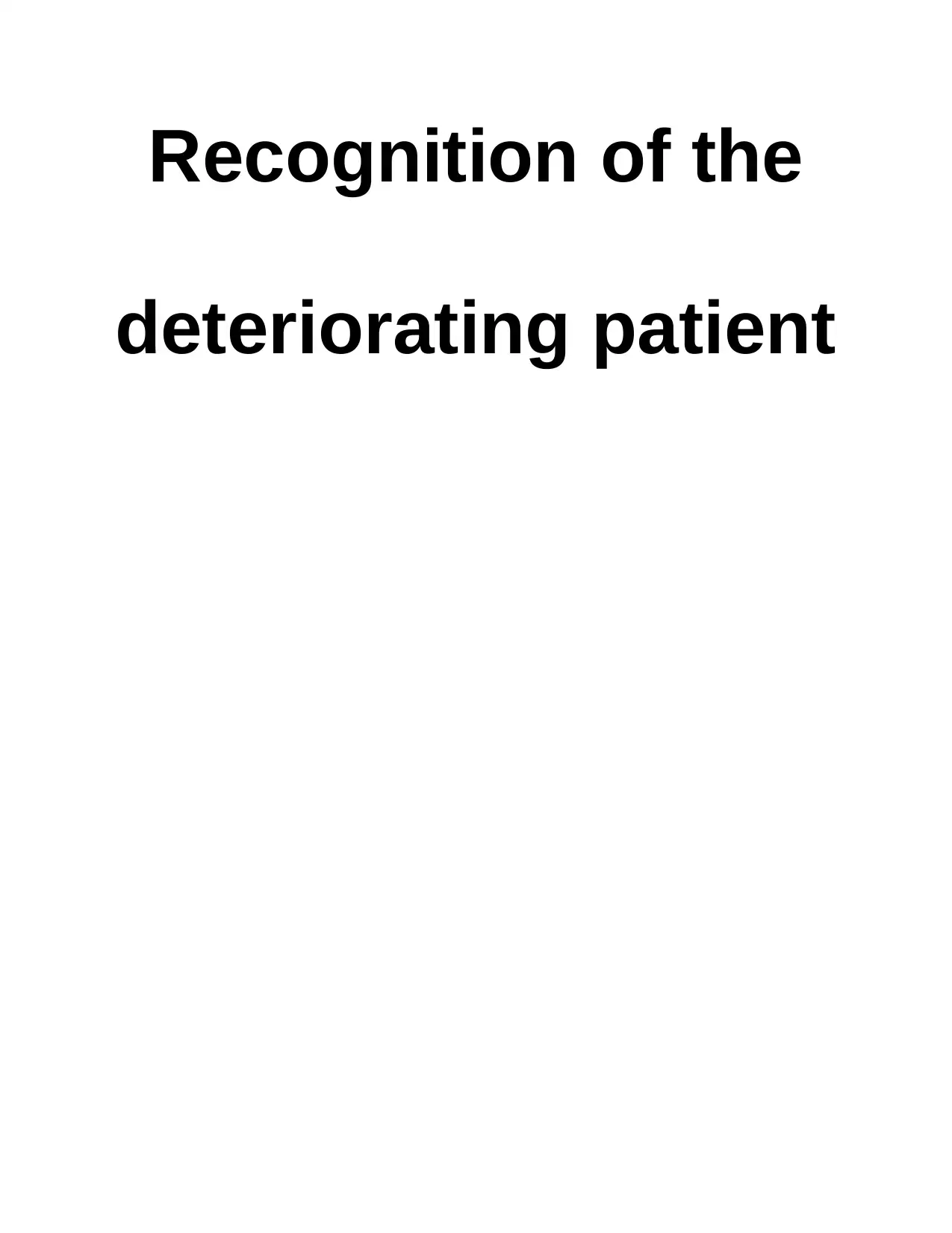
Recognition of the
deteriorating patient
deteriorating patient
Secure Best Marks with AI Grader
Need help grading? Try our AI Grader for instant feedback on your assignments.
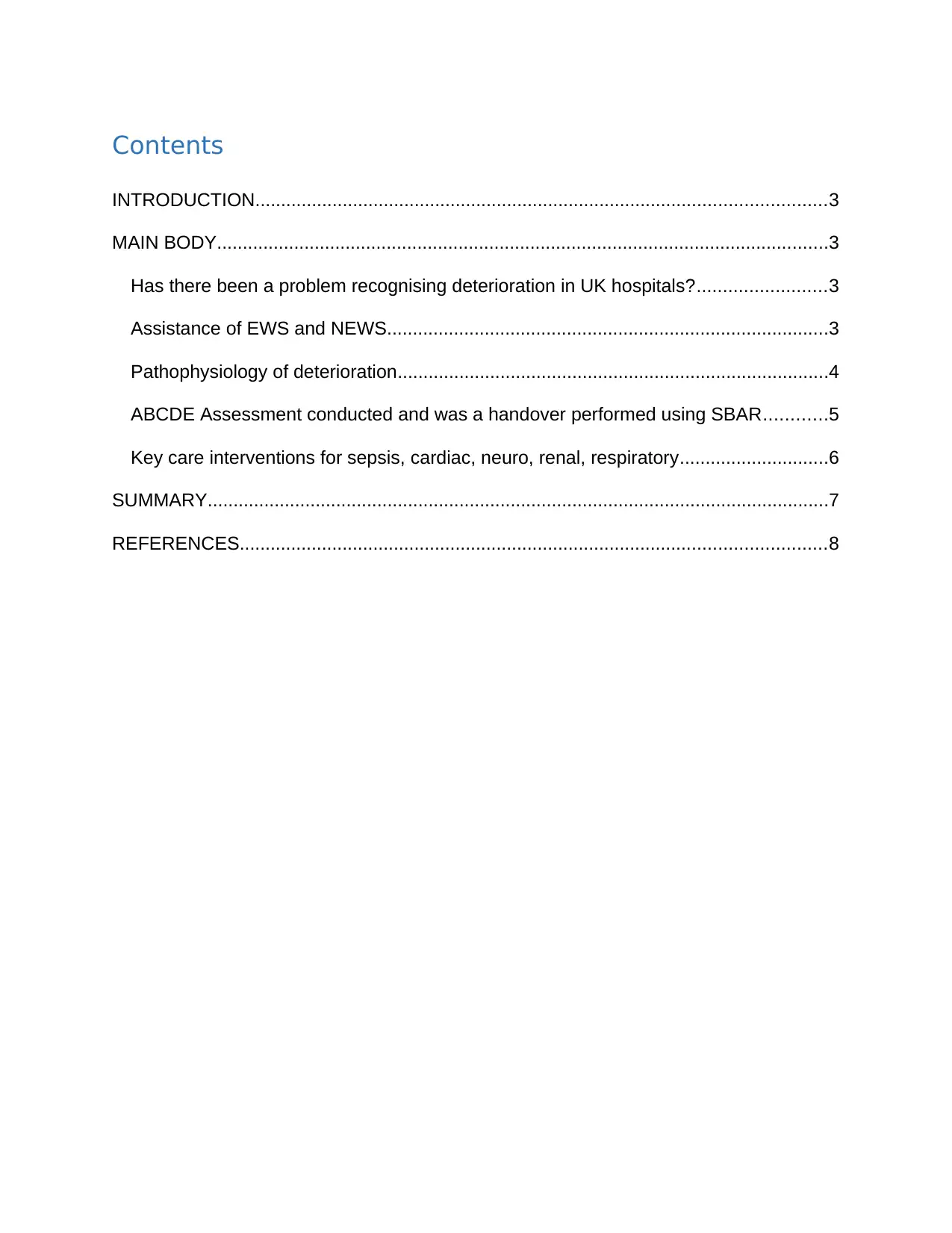
Contents
INTRODUCTION...............................................................................................................3
MAIN BODY.......................................................................................................................3
Has there been a problem recognising deterioration in UK hospitals?.........................3
Assistance of EWS and NEWS......................................................................................3
Pathophysiology of deterioration....................................................................................4
ABCDE Assessment conducted and was a handover performed using SBAR............5
Key care interventions for sepsis, cardiac, neuro, renal, respiratory.............................6
SUMMARY.........................................................................................................................7
REFERENCES..................................................................................................................8
INTRODUCTION...............................................................................................................3
MAIN BODY.......................................................................................................................3
Has there been a problem recognising deterioration in UK hospitals?.........................3
Assistance of EWS and NEWS......................................................................................3
Pathophysiology of deterioration....................................................................................4
ABCDE Assessment conducted and was a handover performed using SBAR............5
Key care interventions for sepsis, cardiac, neuro, renal, respiratory.............................6
SUMMARY.........................................................................................................................7
REFERENCES..................................................................................................................8
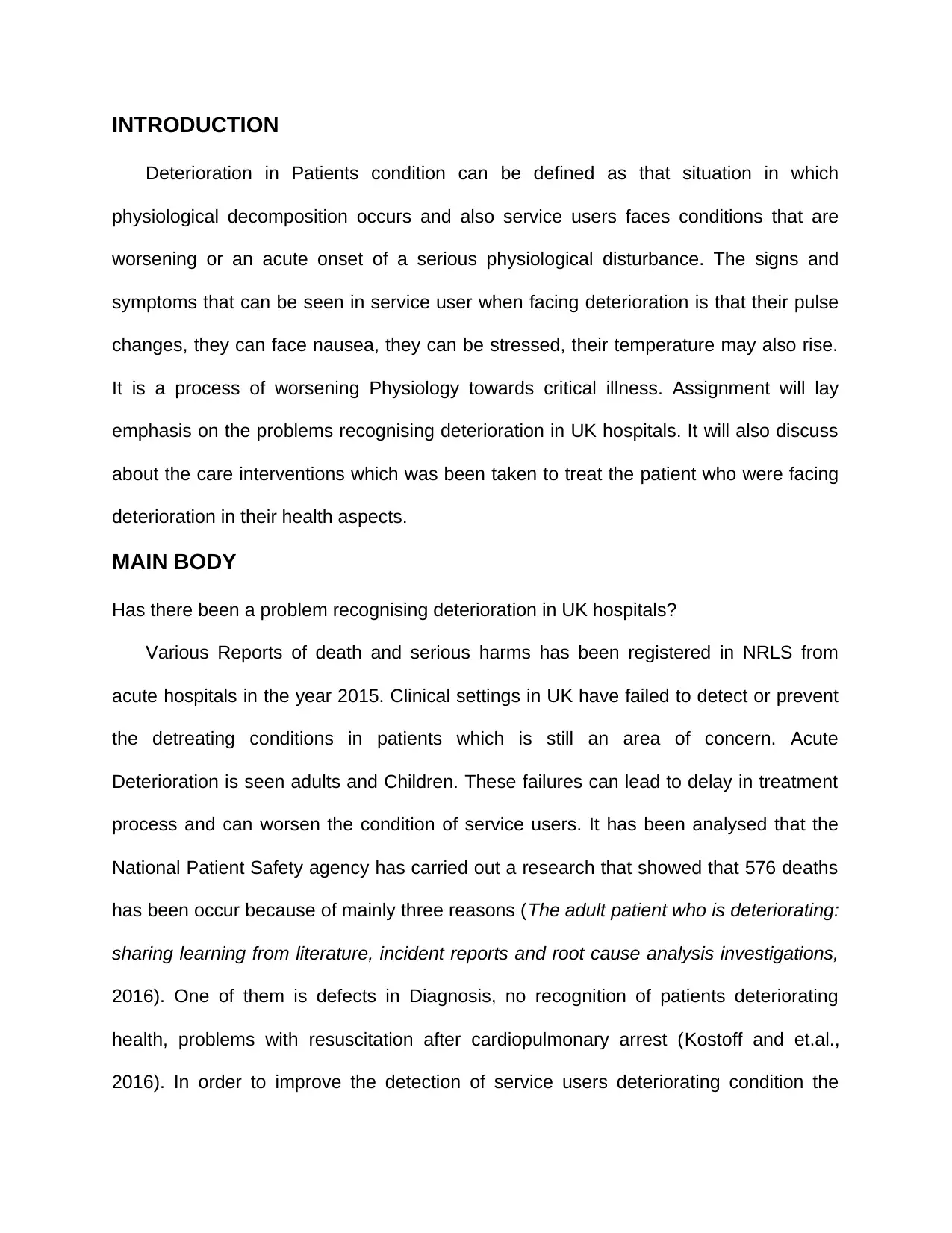
INTRODUCTION
Deterioration in Patients condition can be defined as that situation in which
physiological decomposition occurs and also service users faces conditions that are
worsening or an acute onset of a serious physiological disturbance. The signs and
symptoms that can be seen in service user when facing deterioration is that their pulse
changes, they can face nausea, they can be stressed, their temperature may also rise.
It is a process of worsening Physiology towards critical illness. Assignment will lay
emphasis on the problems recognising deterioration in UK hospitals. It will also discuss
about the care interventions which was been taken to treat the patient who were facing
deterioration in their health aspects.
MAIN BODY
Has there been a problem recognising deterioration in UK hospitals?
Various Reports of death and serious harms has been registered in NRLS from
acute hospitals in the year 2015. Clinical settings in UK have failed to detect or prevent
the detreating conditions in patients which is still an area of concern. Acute
Deterioration is seen adults and Children. These failures can lead to delay in treatment
process and can worsen the condition of service users. It has been analysed that the
National Patient Safety agency has carried out a research that showed that 576 deaths
has been occur because of mainly three reasons (The adult patient who is deteriorating:
sharing learning from literature, incident reports and root cause analysis investigations,
2016). One of them is defects in Diagnosis, no recognition of patients deteriorating
health, problems with resuscitation after cardiopulmonary arrest (Kostoff and et.al.,
2016). In order to improve the detection of service users deteriorating condition the
Deterioration in Patients condition can be defined as that situation in which
physiological decomposition occurs and also service users faces conditions that are
worsening or an acute onset of a serious physiological disturbance. The signs and
symptoms that can be seen in service user when facing deterioration is that their pulse
changes, they can face nausea, they can be stressed, their temperature may also rise.
It is a process of worsening Physiology towards critical illness. Assignment will lay
emphasis on the problems recognising deterioration in UK hospitals. It will also discuss
about the care interventions which was been taken to treat the patient who were facing
deterioration in their health aspects.
MAIN BODY
Has there been a problem recognising deterioration in UK hospitals?
Various Reports of death and serious harms has been registered in NRLS from
acute hospitals in the year 2015. Clinical settings in UK have failed to detect or prevent
the detreating conditions in patients which is still an area of concern. Acute
Deterioration is seen adults and Children. These failures can lead to delay in treatment
process and can worsen the condition of service users. It has been analysed that the
National Patient Safety agency has carried out a research that showed that 576 deaths
has been occur because of mainly three reasons (The adult patient who is deteriorating:
sharing learning from literature, incident reports and root cause analysis investigations,
2016). One of them is defects in Diagnosis, no recognition of patients deteriorating
health, problems with resuscitation after cardiopulmonary arrest (Kostoff and et.al.,
2016). In order to improve the detection of service users deteriorating condition the
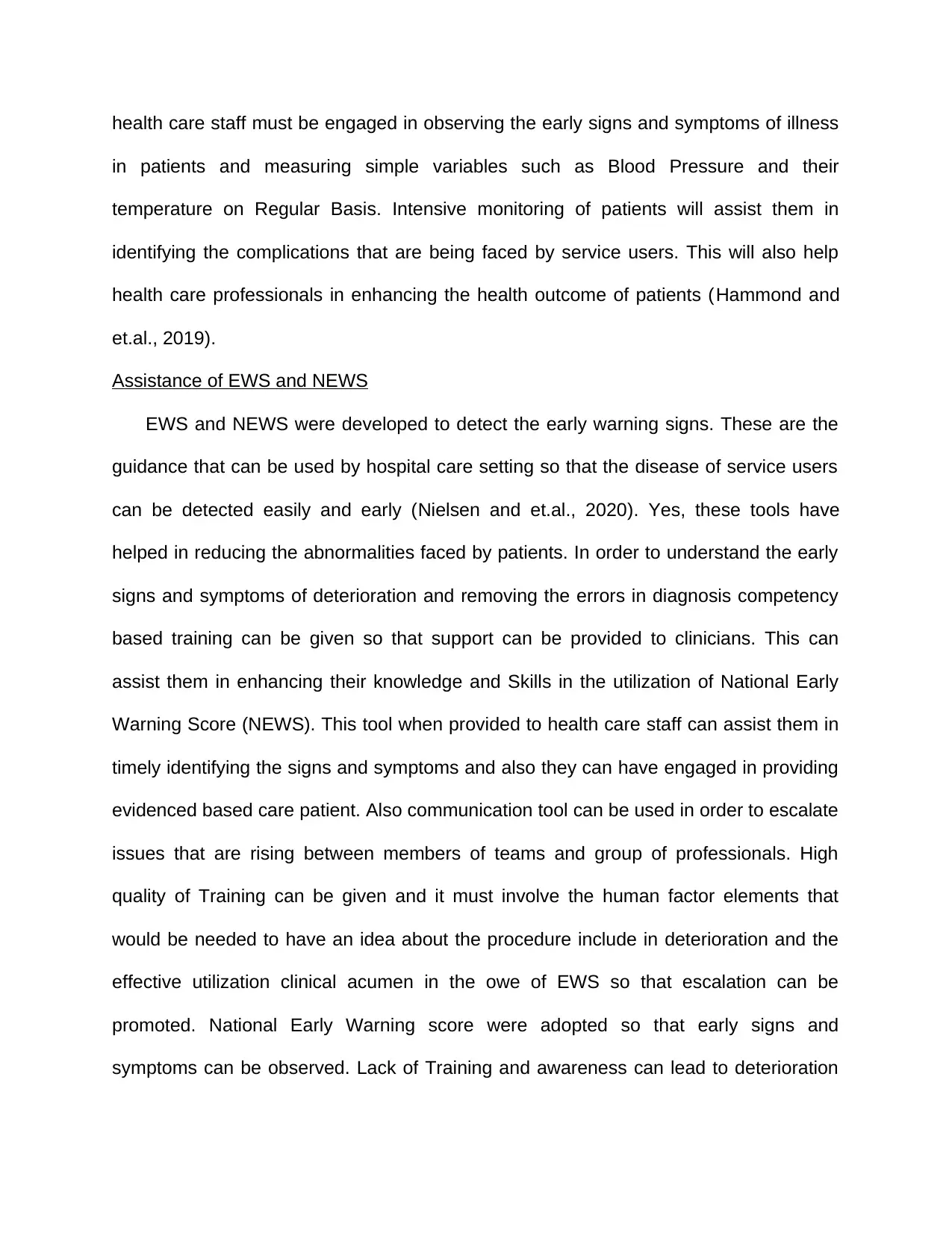
health care staff must be engaged in observing the early signs and symptoms of illness
in patients and measuring simple variables such as Blood Pressure and their
temperature on Regular Basis. Intensive monitoring of patients will assist them in
identifying the complications that are being faced by service users. This will also help
health care professionals in enhancing the health outcome of patients (Hammond and
et.al., 2019).
Assistance of EWS and NEWS
EWS and NEWS were developed to detect the early warning signs. These are the
guidance that can be used by hospital care setting so that the disease of service users
can be detected easily and early (Nielsen and et.al., 2020). Yes, these tools have
helped in reducing the abnormalities faced by patients. In order to understand the early
signs and symptoms of deterioration and removing the errors in diagnosis competency
based training can be given so that support can be provided to clinicians. This can
assist them in enhancing their knowledge and Skills in the utilization of National Early
Warning Score (NEWS). This tool when provided to health care staff can assist them in
timely identifying the signs and symptoms and also they can have engaged in providing
evidenced based care patient. Also communication tool can be used in order to escalate
issues that are rising between members of teams and group of professionals. High
quality of Training can be given and it must involve the human factor elements that
would be needed to have an idea about the procedure include in deterioration and the
effective utilization clinical acumen in the owe of EWS so that escalation can be
promoted. National Early Warning score were adopted so that early signs and
symptoms can be observed. Lack of Training and awareness can lead to deterioration
in patients and measuring simple variables such as Blood Pressure and their
temperature on Regular Basis. Intensive monitoring of patients will assist them in
identifying the complications that are being faced by service users. This will also help
health care professionals in enhancing the health outcome of patients (Hammond and
et.al., 2019).
Assistance of EWS and NEWS
EWS and NEWS were developed to detect the early warning signs. These are the
guidance that can be used by hospital care setting so that the disease of service users
can be detected easily and early (Nielsen and et.al., 2020). Yes, these tools have
helped in reducing the abnormalities faced by patients. In order to understand the early
signs and symptoms of deterioration and removing the errors in diagnosis competency
based training can be given so that support can be provided to clinicians. This can
assist them in enhancing their knowledge and Skills in the utilization of National Early
Warning Score (NEWS). This tool when provided to health care staff can assist them in
timely identifying the signs and symptoms and also they can have engaged in providing
evidenced based care patient. Also communication tool can be used in order to escalate
issues that are rising between members of teams and group of professionals. High
quality of Training can be given and it must involve the human factor elements that
would be needed to have an idea about the procedure include in deterioration and the
effective utilization clinical acumen in the owe of EWS so that escalation can be
promoted. National Early Warning score were adopted so that early signs and
symptoms can be observed. Lack of Training and awareness can lead to deterioration
Secure Best Marks with AI Grader
Need help grading? Try our AI Grader for instant feedback on your assignments.
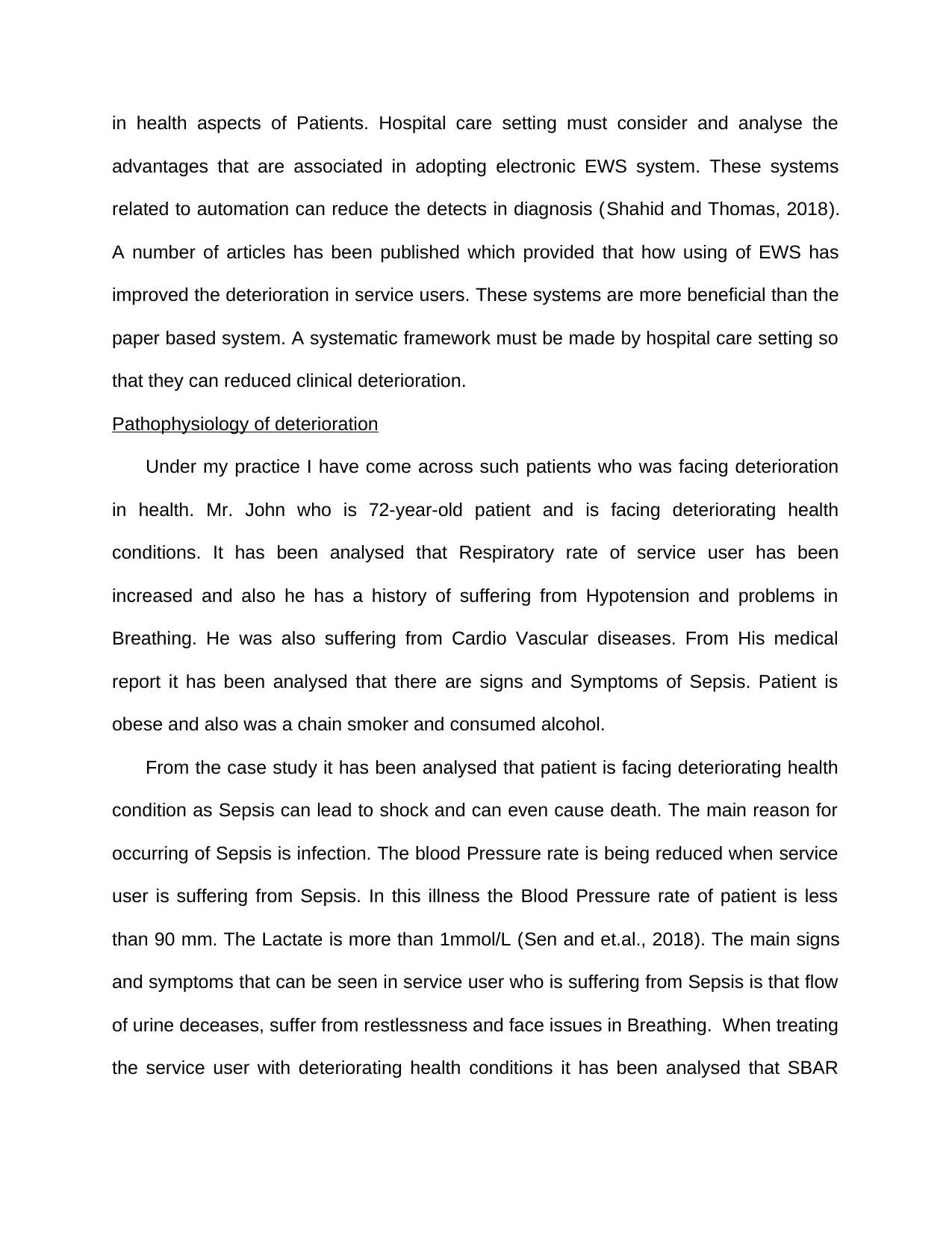
in health aspects of Patients. Hospital care setting must consider and analyse the
advantages that are associated in adopting electronic EWS system. These systems
related to automation can reduce the detects in diagnosis (Shahid and Thomas, 2018).
A number of articles has been published which provided that how using of EWS has
improved the deterioration in service users. These systems are more beneficial than the
paper based system. A systematic framework must be made by hospital care setting so
that they can reduced clinical deterioration.
Pathophysiology of deterioration
Under my practice I have come across such patients who was facing deterioration
in health. Mr. John who is 72-year-old patient and is facing deteriorating health
conditions. It has been analysed that Respiratory rate of service user has been
increased and also he has a history of suffering from Hypotension and problems in
Breathing. He was also suffering from Cardio Vascular diseases. From His medical
report it has been analysed that there are signs and Symptoms of Sepsis. Patient is
obese and also was a chain smoker and consumed alcohol.
From the case study it has been analysed that patient is facing deteriorating health
condition as Sepsis can lead to shock and can even cause death. The main reason for
occurring of Sepsis is infection. The blood Pressure rate is being reduced when service
user is suffering from Sepsis. In this illness the Blood Pressure rate of patient is less
than 90 mm. The Lactate is more than 1mmol/L (Sen and et.al., 2018). The main signs
and symptoms that can be seen in service user who is suffering from Sepsis is that flow
of urine deceases, suffer from restlessness and face issues in Breathing. When treating
the service user with deteriorating health conditions it has been analysed that SBAR
advantages that are associated in adopting electronic EWS system. These systems
related to automation can reduce the detects in diagnosis (Shahid and Thomas, 2018).
A number of articles has been published which provided that how using of EWS has
improved the deterioration in service users. These systems are more beneficial than the
paper based system. A systematic framework must be made by hospital care setting so
that they can reduced clinical deterioration.
Pathophysiology of deterioration
Under my practice I have come across such patients who was facing deterioration
in health. Mr. John who is 72-year-old patient and is facing deteriorating health
conditions. It has been analysed that Respiratory rate of service user has been
increased and also he has a history of suffering from Hypotension and problems in
Breathing. He was also suffering from Cardio Vascular diseases. From His medical
report it has been analysed that there are signs and Symptoms of Sepsis. Patient is
obese and also was a chain smoker and consumed alcohol.
From the case study it has been analysed that patient is facing deteriorating health
condition as Sepsis can lead to shock and can even cause death. The main reason for
occurring of Sepsis is infection. The blood Pressure rate is being reduced when service
user is suffering from Sepsis. In this illness the Blood Pressure rate of patient is less
than 90 mm. The Lactate is more than 1mmol/L (Sen and et.al., 2018). The main signs
and symptoms that can be seen in service user who is suffering from Sepsis is that flow
of urine deceases, suffer from restlessness and face issues in Breathing. When treating
the service user with deteriorating health conditions it has been analysed that SBAR
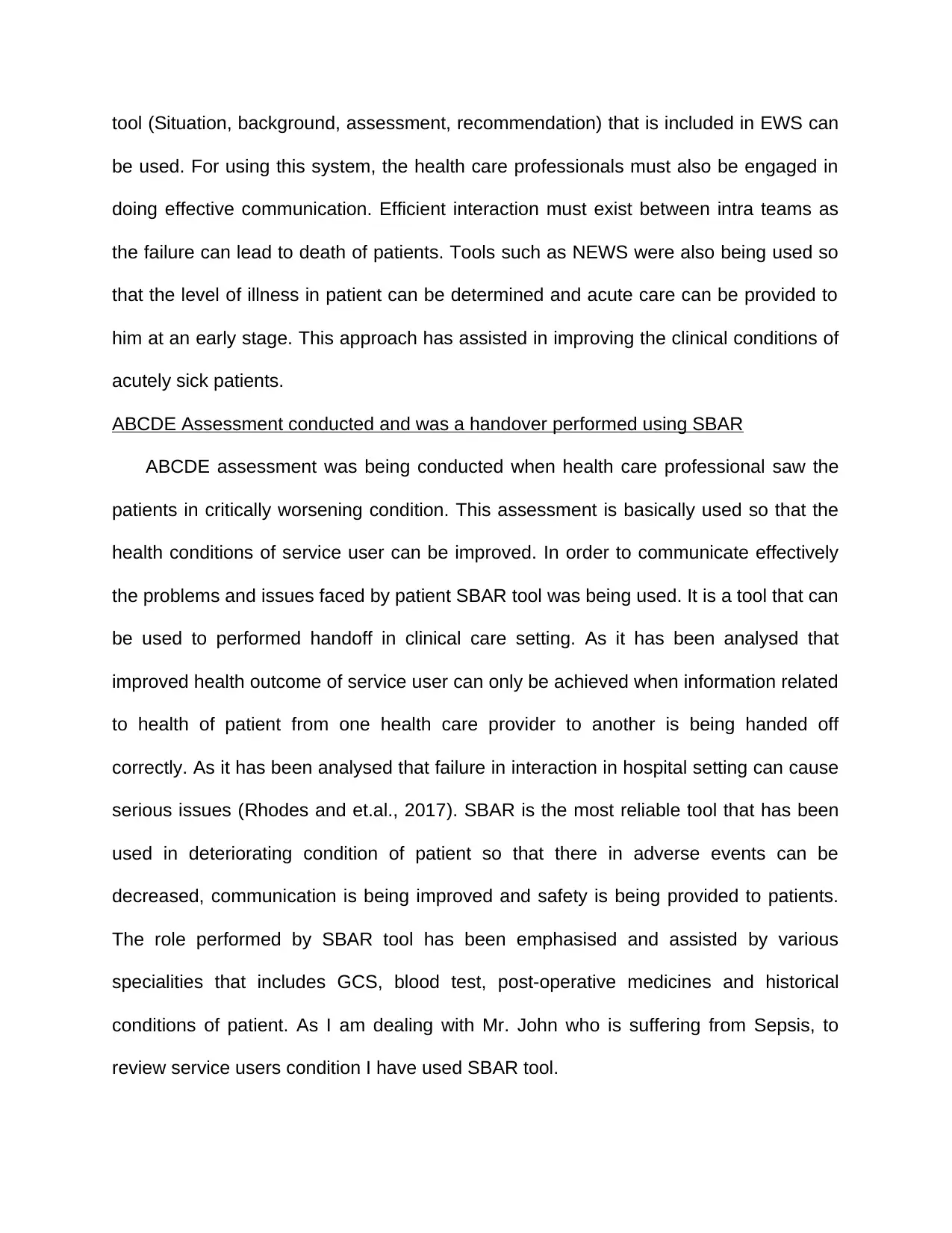
tool (Situation, background, assessment, recommendation) that is included in EWS can
be used. For using this system, the health care professionals must also be engaged in
doing effective communication. Efficient interaction must exist between intra teams as
the failure can lead to death of patients. Tools such as NEWS were also being used so
that the level of illness in patient can be determined and acute care can be provided to
him at an early stage. This approach has assisted in improving the clinical conditions of
acutely sick patients.
ABCDE Assessment conducted and was a handover performed using SBAR
ABCDE assessment was being conducted when health care professional saw the
patients in critically worsening condition. This assessment is basically used so that the
health conditions of service user can be improved. In order to communicate effectively
the problems and issues faced by patient SBAR tool was being used. It is a tool that can
be used to performed handoff in clinical care setting. As it has been analysed that
improved health outcome of service user can only be achieved when information related
to health of patient from one health care provider to another is being handed off
correctly. As it has been analysed that failure in interaction in hospital setting can cause
serious issues (Rhodes and et.al., 2017). SBAR is the most reliable tool that has been
used in deteriorating condition of patient so that there in adverse events can be
decreased, communication is being improved and safety is being provided to patients.
The role performed by SBAR tool has been emphasised and assisted by various
specialities that includes GCS, blood test, post-operative medicines and historical
conditions of patient. As I am dealing with Mr. John who is suffering from Sepsis, to
review service users condition I have used SBAR tool.
be used. For using this system, the health care professionals must also be engaged in
doing effective communication. Efficient interaction must exist between intra teams as
the failure can lead to death of patients. Tools such as NEWS were also being used so
that the level of illness in patient can be determined and acute care can be provided to
him at an early stage. This approach has assisted in improving the clinical conditions of
acutely sick patients.
ABCDE Assessment conducted and was a handover performed using SBAR
ABCDE assessment was being conducted when health care professional saw the
patients in critically worsening condition. This assessment is basically used so that the
health conditions of service user can be improved. In order to communicate effectively
the problems and issues faced by patient SBAR tool was being used. It is a tool that can
be used to performed handoff in clinical care setting. As it has been analysed that
improved health outcome of service user can only be achieved when information related
to health of patient from one health care provider to another is being handed off
correctly. As it has been analysed that failure in interaction in hospital setting can cause
serious issues (Rhodes and et.al., 2017). SBAR is the most reliable tool that has been
used in deteriorating condition of patient so that there in adverse events can be
decreased, communication is being improved and safety is being provided to patients.
The role performed by SBAR tool has been emphasised and assisted by various
specialities that includes GCS, blood test, post-operative medicines and historical
conditions of patient. As I am dealing with Mr. John who is suffering from Sepsis, to
review service users condition I have used SBAR tool.
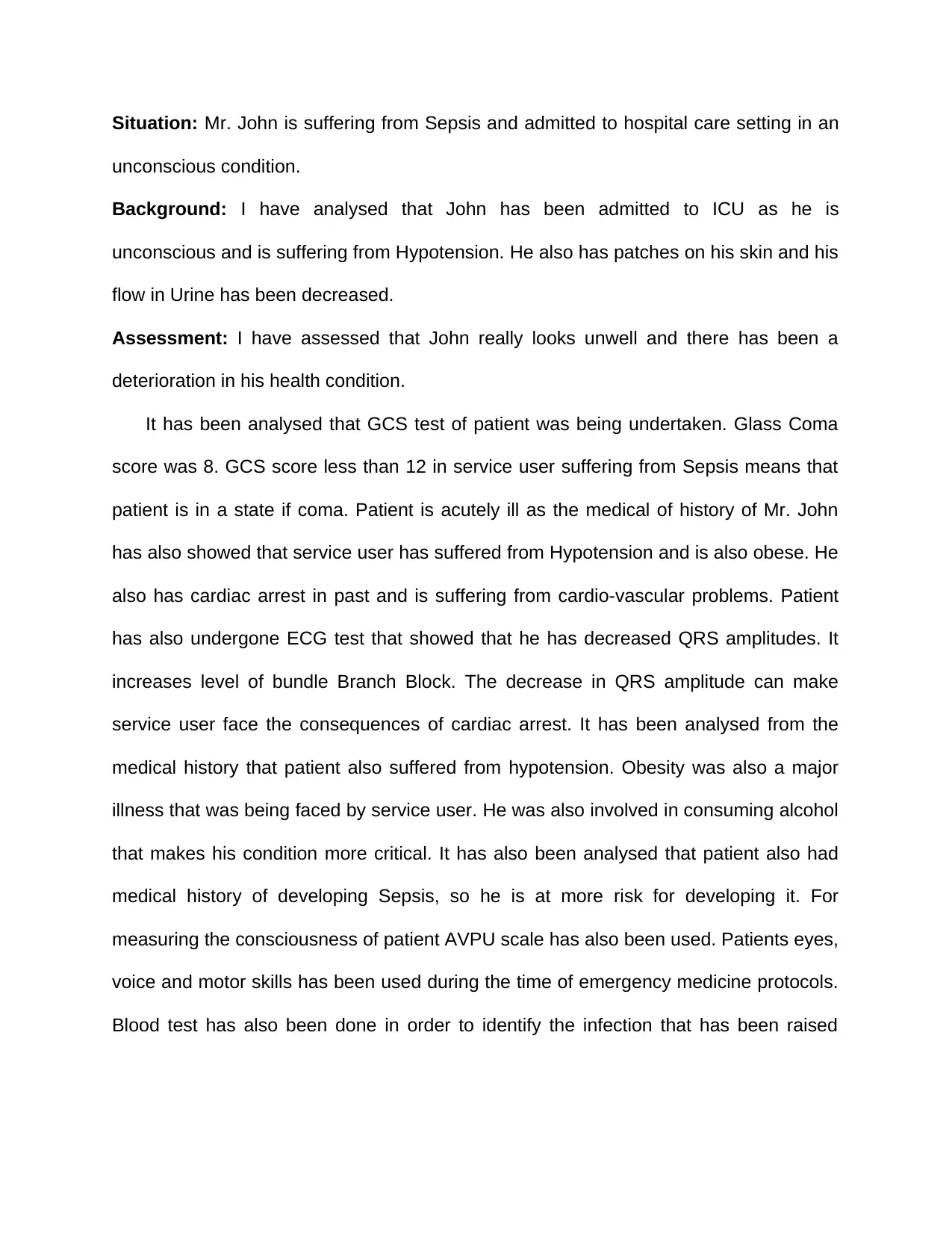
Situation: Mr. John is suffering from Sepsis and admitted to hospital care setting in an
unconscious condition.
Background: I have analysed that John has been admitted to ICU as he is
unconscious and is suffering from Hypotension. He also has patches on his skin and his
flow in Urine has been decreased.
Assessment: I have assessed that John really looks unwell and there has been a
deterioration in his health condition.
It has been analysed that GCS test of patient was being undertaken. Glass Coma
score was 8. GCS score less than 12 in service user suffering from Sepsis means that
patient is in a state if coma. Patient is acutely ill as the medical of history of Mr. John
has also showed that service user has suffered from Hypotension and is also obese. He
also has cardiac arrest in past and is suffering from cardio-vascular problems. Patient
has also undergone ECG test that showed that he has decreased QRS amplitudes. It
increases level of bundle Branch Block. The decrease in QRS amplitude can make
service user face the consequences of cardiac arrest. It has been analysed from the
medical history that patient also suffered from hypotension. Obesity was also a major
illness that was being faced by service user. He was also involved in consuming alcohol
that makes his condition more critical. It has also been analysed that patient also had
medical history of developing Sepsis, so he is at more risk for developing it. For
measuring the consciousness of patient AVPU scale has also been used. Patients eyes,
voice and motor skills has been used during the time of emergency medicine protocols.
Blood test has also been done in order to identify the infection that has been raised
unconscious condition.
Background: I have analysed that John has been admitted to ICU as he is
unconscious and is suffering from Hypotension. He also has patches on his skin and his
flow in Urine has been decreased.
Assessment: I have assessed that John really looks unwell and there has been a
deterioration in his health condition.
It has been analysed that GCS test of patient was being undertaken. Glass Coma
score was 8. GCS score less than 12 in service user suffering from Sepsis means that
patient is in a state if coma. Patient is acutely ill as the medical of history of Mr. John
has also showed that service user has suffered from Hypotension and is also obese. He
also has cardiac arrest in past and is suffering from cardio-vascular problems. Patient
has also undergone ECG test that showed that he has decreased QRS amplitudes. It
increases level of bundle Branch Block. The decrease in QRS amplitude can make
service user face the consequences of cardiac arrest. It has been analysed from the
medical history that patient also suffered from hypotension. Obesity was also a major
illness that was being faced by service user. He was also involved in consuming alcohol
that makes his condition more critical. It has also been analysed that patient also had
medical history of developing Sepsis, so he is at more risk for developing it. For
measuring the consciousness of patient AVPU scale has also been used. Patients eyes,
voice and motor skills has been used during the time of emergency medicine protocols.
Blood test has also been done in order to identify the infection that has been raised
Paraphrase This Document
Need a fresh take? Get an instant paraphrase of this document with our AI Paraphraser
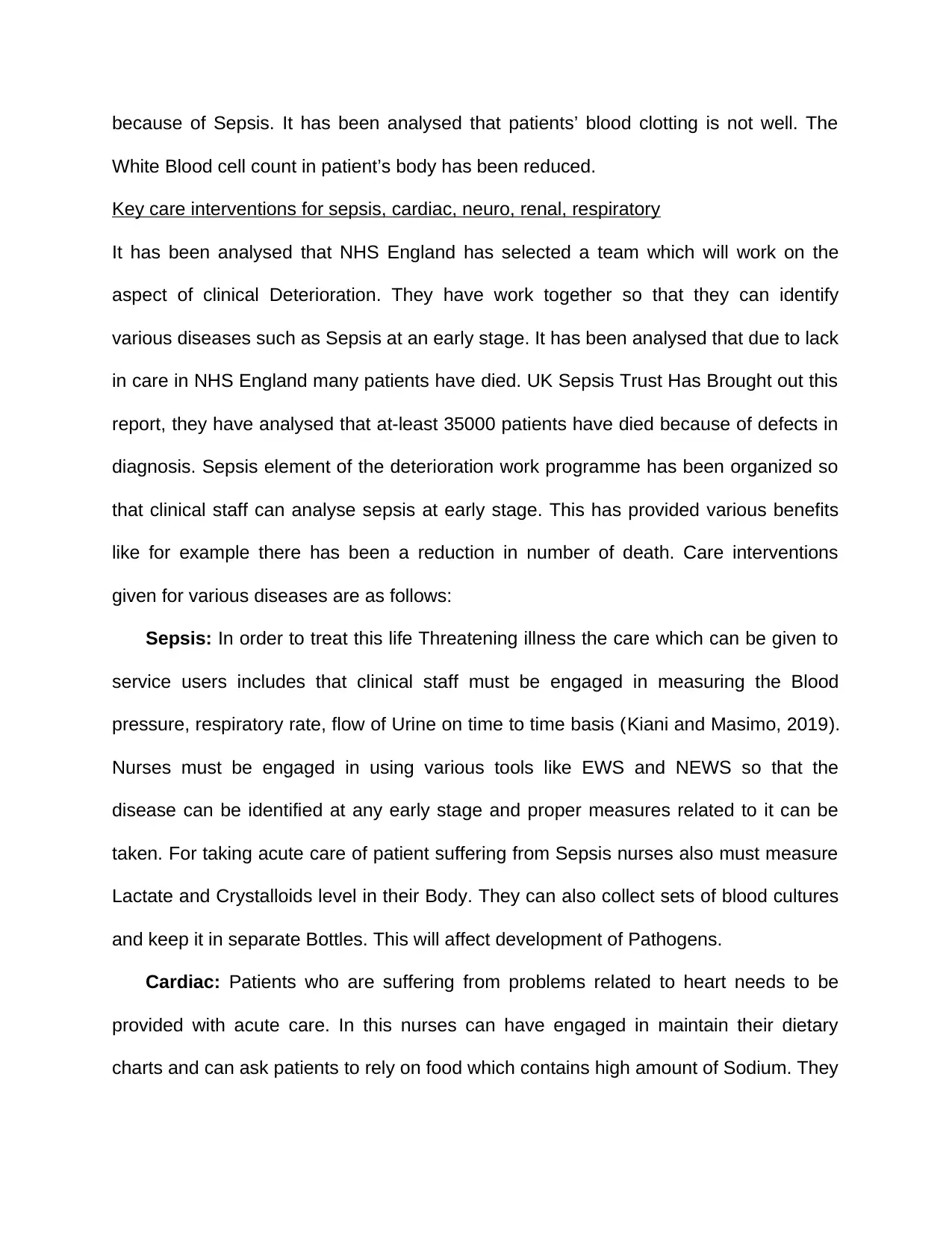
because of Sepsis. It has been analysed that patients’ blood clotting is not well. The
White Blood cell count in patient’s body has been reduced.
Key care interventions for sepsis, cardiac, neuro, renal, respiratory
It has been analysed that NHS England has selected a team which will work on the
aspect of clinical Deterioration. They have work together so that they can identify
various diseases such as Sepsis at an early stage. It has been analysed that due to lack
in care in NHS England many patients have died. UK Sepsis Trust Has Brought out this
report, they have analysed that at-least 35000 patients have died because of defects in
diagnosis. Sepsis element of the deterioration work programme has been organized so
that clinical staff can analyse sepsis at early stage. This has provided various benefits
like for example there has been a reduction in number of death. Care interventions
given for various diseases are as follows:
Sepsis: In order to treat this life Threatening illness the care which can be given to
service users includes that clinical staff must be engaged in measuring the Blood
pressure, respiratory rate, flow of Urine on time to time basis (Kiani and Masimo, 2019).
Nurses must be engaged in using various tools like EWS and NEWS so that the
disease can be identified at any early stage and proper measures related to it can be
taken. For taking acute care of patient suffering from Sepsis nurses also must measure
Lactate and Crystalloids level in their Body. They can also collect sets of blood cultures
and keep it in separate Bottles. This will affect development of Pathogens.
Cardiac: Patients who are suffering from problems related to heart needs to be
provided with acute care. In this nurses can have engaged in maintain their dietary
charts and can ask patients to rely on food which contains high amount of Sodium. They
White Blood cell count in patient’s body has been reduced.
Key care interventions for sepsis, cardiac, neuro, renal, respiratory
It has been analysed that NHS England has selected a team which will work on the
aspect of clinical Deterioration. They have work together so that they can identify
various diseases such as Sepsis at an early stage. It has been analysed that due to lack
in care in NHS England many patients have died. UK Sepsis Trust Has Brought out this
report, they have analysed that at-least 35000 patients have died because of defects in
diagnosis. Sepsis element of the deterioration work programme has been organized so
that clinical staff can analyse sepsis at early stage. This has provided various benefits
like for example there has been a reduction in number of death. Care interventions
given for various diseases are as follows:
Sepsis: In order to treat this life Threatening illness the care which can be given to
service users includes that clinical staff must be engaged in measuring the Blood
pressure, respiratory rate, flow of Urine on time to time basis (Kiani and Masimo, 2019).
Nurses must be engaged in using various tools like EWS and NEWS so that the
disease can be identified at any early stage and proper measures related to it can be
taken. For taking acute care of patient suffering from Sepsis nurses also must measure
Lactate and Crystalloids level in their Body. They can also collect sets of blood cultures
and keep it in separate Bottles. This will affect development of Pathogens.
Cardiac: Patients who are suffering from problems related to heart needs to be
provided with acute care. In this nurses can have engaged in maintain their dietary
charts and can ask patients to rely on food which contains high amount of Sodium. They
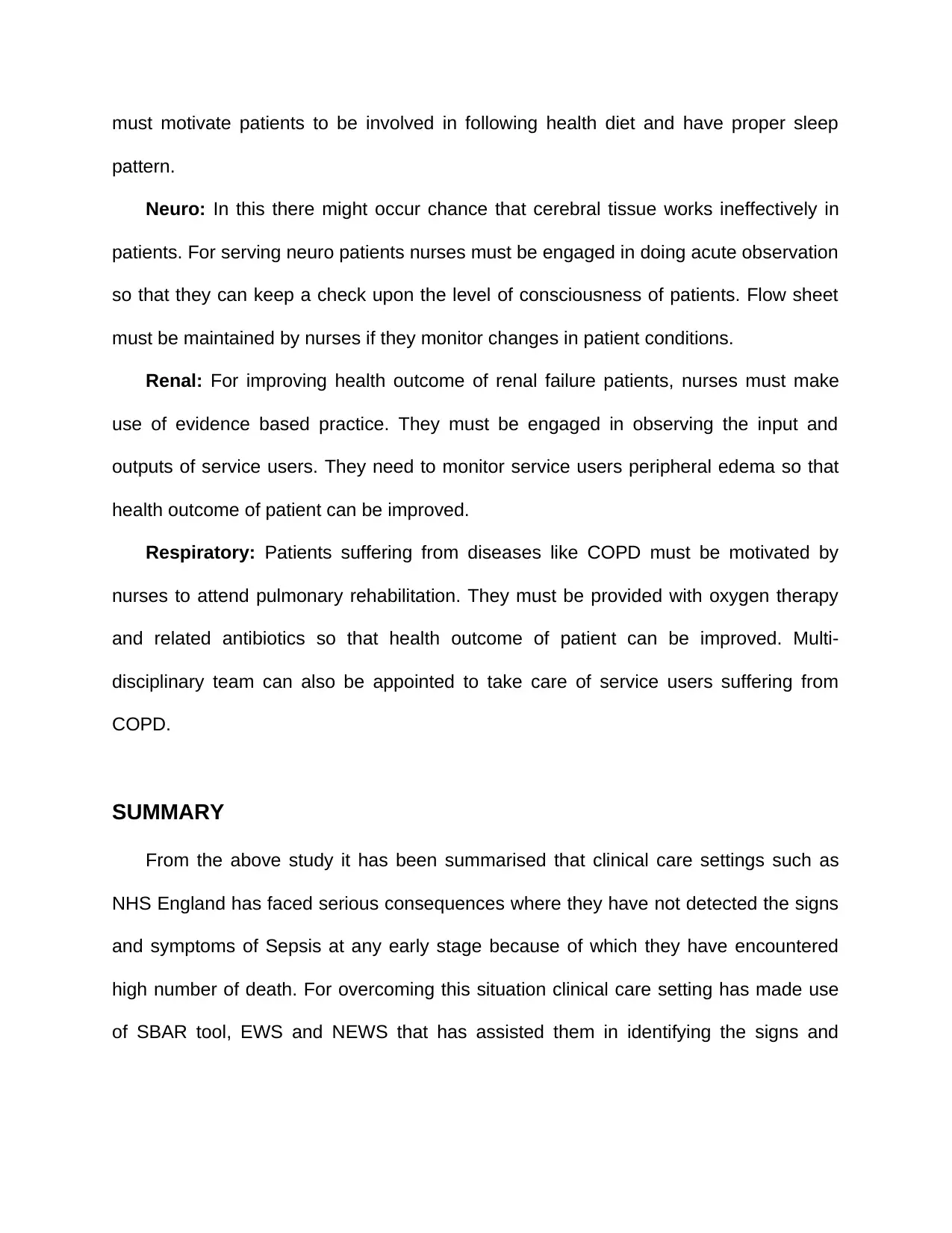
must motivate patients to be involved in following health diet and have proper sleep
pattern.
Neuro: In this there might occur chance that cerebral tissue works ineffectively in
patients. For serving neuro patients nurses must be engaged in doing acute observation
so that they can keep a check upon the level of consciousness of patients. Flow sheet
must be maintained by nurses if they monitor changes in patient conditions.
Renal: For improving health outcome of renal failure patients, nurses must make
use of evidence based practice. They must be engaged in observing the input and
outputs of service users. They need to monitor service users peripheral edema so that
health outcome of patient can be improved.
Respiratory: Patients suffering from diseases like COPD must be motivated by
nurses to attend pulmonary rehabilitation. They must be provided with oxygen therapy
and related antibiotics so that health outcome of patient can be improved. Multi-
disciplinary team can also be appointed to take care of service users suffering from
COPD.
SUMMARY
From the above study it has been summarised that clinical care settings such as
NHS England has faced serious consequences where they have not detected the signs
and symptoms of Sepsis at any early stage because of which they have encountered
high number of death. For overcoming this situation clinical care setting has made use
of SBAR tool, EWS and NEWS that has assisted them in identifying the signs and
pattern.
Neuro: In this there might occur chance that cerebral tissue works ineffectively in
patients. For serving neuro patients nurses must be engaged in doing acute observation
so that they can keep a check upon the level of consciousness of patients. Flow sheet
must be maintained by nurses if they monitor changes in patient conditions.
Renal: For improving health outcome of renal failure patients, nurses must make
use of evidence based practice. They must be engaged in observing the input and
outputs of service users. They need to monitor service users peripheral edema so that
health outcome of patient can be improved.
Respiratory: Patients suffering from diseases like COPD must be motivated by
nurses to attend pulmonary rehabilitation. They must be provided with oxygen therapy
and related antibiotics so that health outcome of patient can be improved. Multi-
disciplinary team can also be appointed to take care of service users suffering from
COPD.
SUMMARY
From the above study it has been summarised that clinical care settings such as
NHS England has faced serious consequences where they have not detected the signs
and symptoms of Sepsis at any early stage because of which they have encountered
high number of death. For overcoming this situation clinical care setting has made use
of SBAR tool, EWS and NEWS that has assisted them in identifying the signs and
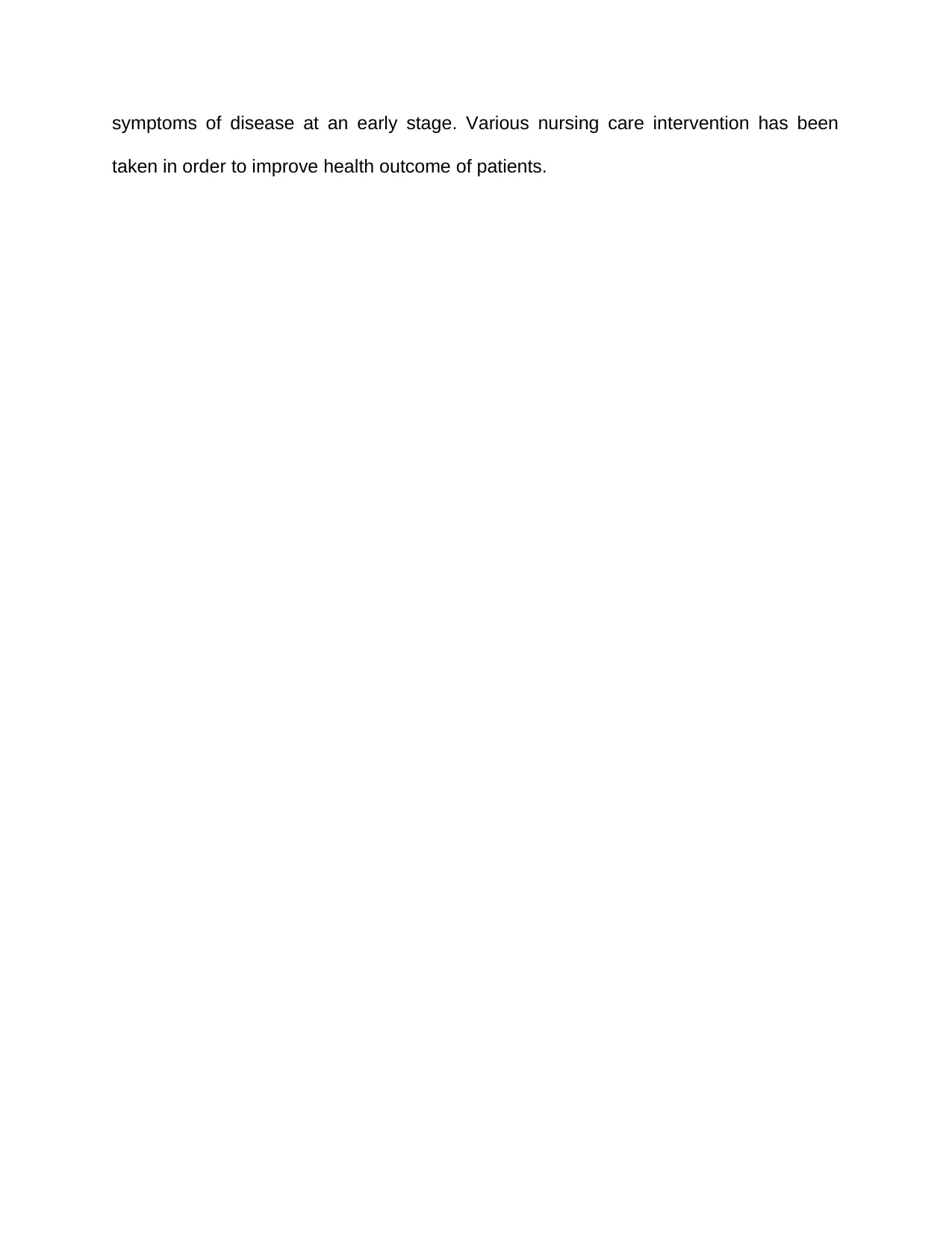
symptoms of disease at an early stage. Various nursing care intervention has been
taken in order to improve health outcome of patients.
taken in order to improve health outcome of patients.
Secure Best Marks with AI Grader
Need help grading? Try our AI Grader for instant feedback on your assignments.
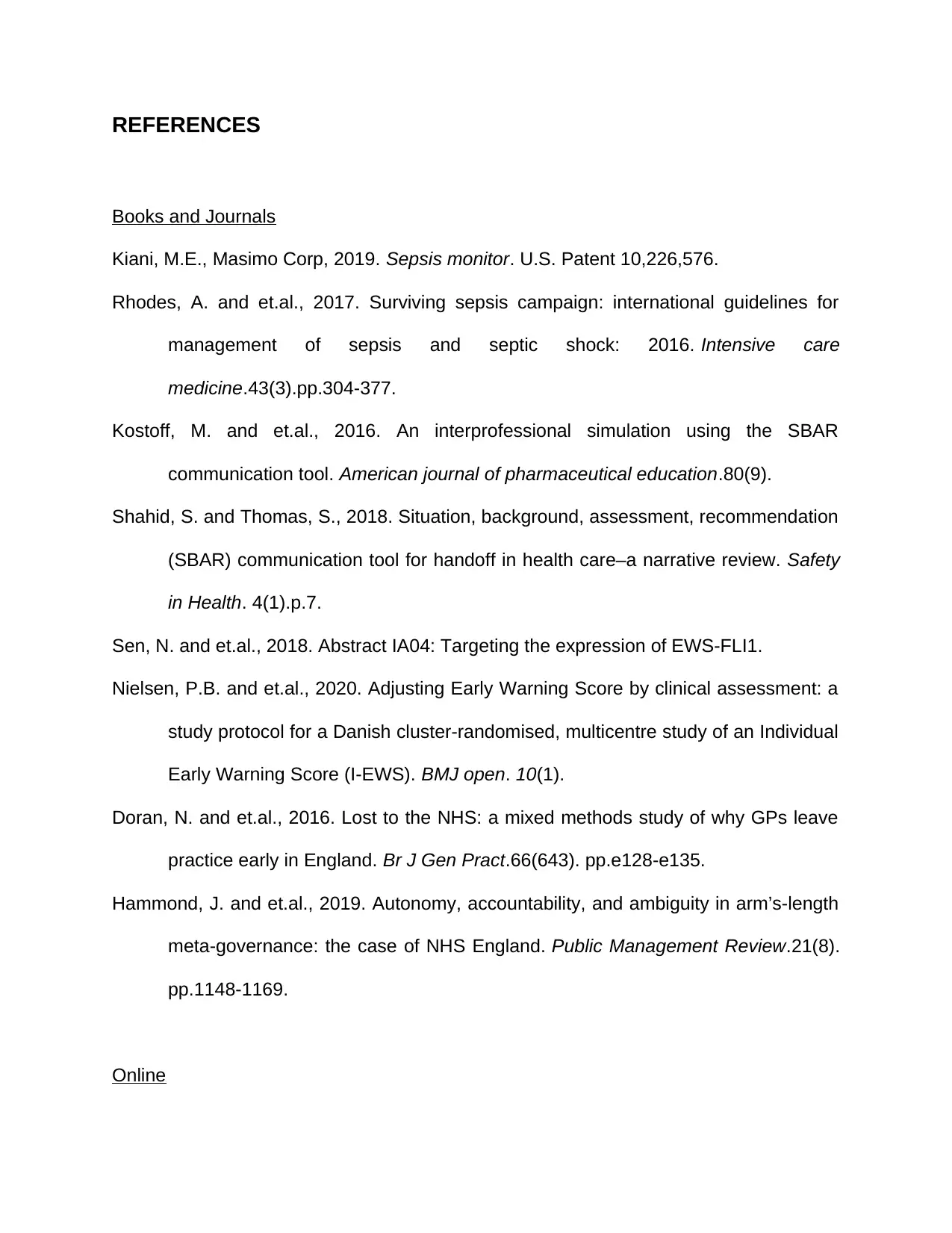
REFERENCES
Books and Journals
Kiani, M.E., Masimo Corp, 2019. Sepsis monitor. U.S. Patent 10,226,576.
Rhodes, A. and et.al., 2017. Surviving sepsis campaign: international guidelines for
management of sepsis and septic shock: 2016. Intensive care
medicine.43(3).pp.304-377.
Kostoff, M. and et.al., 2016. An interprofessional simulation using the SBAR
communication tool. American journal of pharmaceutical education.80(9).
Shahid, S. and Thomas, S., 2018. Situation, background, assessment, recommendation
(SBAR) communication tool for handoff in health care–a narrative review. Safety
in Health. 4(1).p.7.
Sen, N. and et.al., 2018. Abstract IA04: Targeting the expression of EWS-FLI1.
Nielsen, P.B. and et.al., 2020. Adjusting Early Warning Score by clinical assessment: a
study protocol for a Danish cluster-randomised, multicentre study of an Individual
Early Warning Score (I-EWS). BMJ open. 10(1).
Doran, N. and et.al., 2016. Lost to the NHS: a mixed methods study of why GPs leave
practice early in England. Br J Gen Pract.66(643). pp.e128-e135.
Hammond, J. and et.al., 2019. Autonomy, accountability, and ambiguity in arm’s-length
meta-governance: the case of NHS England. Public Management Review.21(8).
pp.1148-1169.
Online
Books and Journals
Kiani, M.E., Masimo Corp, 2019. Sepsis monitor. U.S. Patent 10,226,576.
Rhodes, A. and et.al., 2017. Surviving sepsis campaign: international guidelines for
management of sepsis and septic shock: 2016. Intensive care
medicine.43(3).pp.304-377.
Kostoff, M. and et.al., 2016. An interprofessional simulation using the SBAR
communication tool. American journal of pharmaceutical education.80(9).
Shahid, S. and Thomas, S., 2018. Situation, background, assessment, recommendation
(SBAR) communication tool for handoff in health care–a narrative review. Safety
in Health. 4(1).p.7.
Sen, N. and et.al., 2018. Abstract IA04: Targeting the expression of EWS-FLI1.
Nielsen, P.B. and et.al., 2020. Adjusting Early Warning Score by clinical assessment: a
study protocol for a Danish cluster-randomised, multicentre study of an Individual
Early Warning Score (I-EWS). BMJ open. 10(1).
Doran, N. and et.al., 2016. Lost to the NHS: a mixed methods study of why GPs leave
practice early in England. Br J Gen Pract.66(643). pp.e128-e135.
Hammond, J. and et.al., 2019. Autonomy, accountability, and ambiguity in arm’s-length
meta-governance: the case of NHS England. Public Management Review.21(8).
pp.1148-1169.
Online
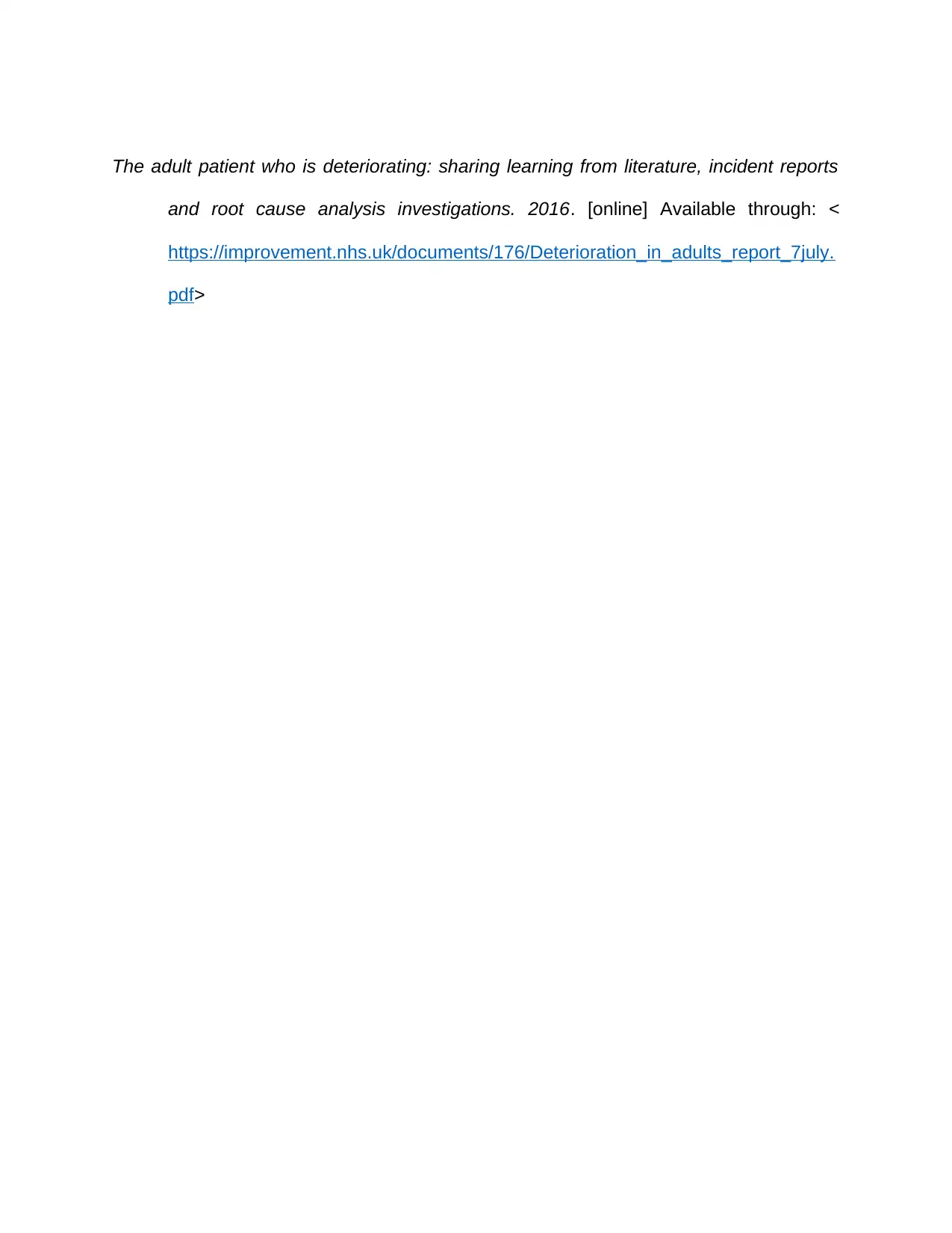
The adult patient who is deteriorating: sharing learning from literature, incident reports
and root cause analysis investigations. 2016. [online] Available through: <
https://improvement.nhs.uk/documents/176/Deterioration_in_adults_report_7july.
pdf>
and root cause analysis investigations. 2016. [online] Available through: <
https://improvement.nhs.uk/documents/176/Deterioration_in_adults_report_7july.
pdf>

1
1 out of 13
Related Documents
Your All-in-One AI-Powered Toolkit for Academic Success.
+13062052269
info@desklib.com
Available 24*7 on WhatsApp / Email
![[object Object]](/_next/static/media/star-bottom.7253800d.svg)
Unlock your academic potential
© 2024 | Zucol Services PVT LTD | All rights reserved.





